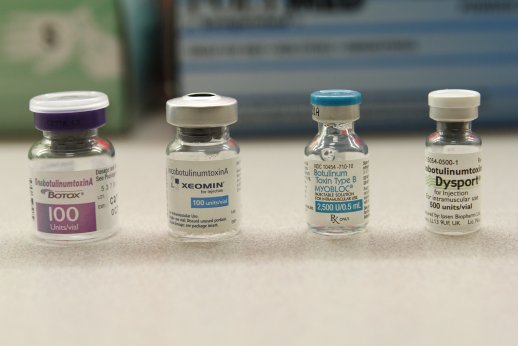This is guided by treating the underlying cause or if that is unknown treatment targets the symptoms of dystonia itself.
Medications
- Levodopa – (Sinemet, Prolopa) will work well in an inherited type of dystonia called the “Segawa variant”, and under modern classification schemes is called DYT5 – “Dopa-reponsive dystonia”. This condition usually starts in childhood, and can be mistaken for cerebral palsy. The children get worse during the day and usually is associated with some features of Parkinsonism. Even though the Segawa variant is rare doctors will often try levodopa just in case the patient responds. This condition can rarely present as a focal dystonia in adults.
- Anticholinergics – (e.g. Artane, Cogentin, Parsitan) have been the main group of drugs used to treat dystonia. Among the oral medication options, they are often considered “the treatment of choice” meaning that they are the most likely to work with the least side effects. They work up to 40% of the time in young adults. They are less well tolerated in older patients. The side effects are tolerated better in children, and higher doses can be reached, resulting in a higher rate of success in this age group.
- Tetrabenazine – (Nitoman) acts to block the re-uptake of dopamine into nerve cells, thereby increasing the effect of dopamine in the brain; this medication must be used with caution, as it can worsen depression and increase the risk of suicide.
Other classes of medications include
- Muscle relaxants – (Baclofen)
- Benzodiazepines – (Vallium/diazepam, Ativan/lorazepam, clonazepam) can be helpful for some people with dystonia that is aggravated by anxiety. These have addicting potential, and therefore have to be used with caution.
- Anticonvulsants – (Tegretol/carbamazepine)
Combinations of medications will sometimes be necessary including one combination referred to as “Triple Therapy” by Marsden: This “cocktail” includes a combination of an anticholinergic, diazepam and tetrabenazine.
Botulinum Toxin Injections
Botulnum toxin was first identified by Dr. Allan Scott as a chemical whose action may help a variety of disorders characterized by overactivity of muscle activity. This toxin is purified from cultures of living bacteria, and comes packaged in its dry, crystallized form.

Botox (now marketed by Abbvie) is a form of botulinum toxin that is kept frozen until use. Xeomin (by Merz) is one that can be maintained at room temperature. Myobloc is one that comes in liquid form but is restricted to access in Canada. Dysport is a product more widely used in Europe, but is now available in Canada. Patients are treated by injecting the toxin (dissolved in saline) directly into the dystonic muscles. The effect (weakness of the injected muscle) is evident in 2 – 3 days, and the full effect is seen within 1 month. The effect on the target muscle typically lasts a duration of 3-4 months.
Advantage of this approach are fewer potential systemic side effects (by comparison to oral medications) and no permanent alterations to person’s physiology. However, it is not a cure and cost can be a barrier for some.
Approximate success rate in different types of dystonia; please note – success is highly dependent on the skill and experience of the physician performing the injection.
- Blepharospasm …………………………….. 90%
- Cervical dystonia (“torticollis”) ……. 90% pain reduction, 70% reduction of movement
- Spasmodic Dysphonia …………………… 70-85%
- Jaw closing dystonia ……………………… 60-80%
- Jaw opening dystonia ……………………. 40-50%
- Writer’s cramp ……………………………….. 15-20%
Surgical options
- Peripheral Denervation – by cutting the nerves to a dystonic muscle or group of muscles, the dystonic contractions may be reduced. This procedure is no longer done, as it results in permanent paralysis of the target muscle.
- Functional Stereotactic lesioning – (Gamma Knife Surgery or Focused Ultrasound) a minimally invasive procedure that surgically destroys a very small area deep within the brain where dystonia may originate from, or be transmitted through. This procedure, if successful, will stop or reduce the dystonia on the opposite side of the body. This type of procedure tends to help distal (forearm, hand, or foot) dystonia the most. The two regions that have been lesioned with some success in dystonia include the thalamus, and the globus pallidus. There are, as with any surgical procedure, possible side effects that need to be discussed and considered.
- Another option is to implant a Deep Brain Stimulator – a small electrode implanted into the brain that is connected to a programmable transmitter under the chest wall, like a pacemaker. By electrically interfering with the natural firing pattern of the nerve cells in this area, the dystonia is electrically suppressed. This procedure has been proven effective for inherited forms of generalized dystonia and more recently is proving successful for other refractory focal forms of dystonia. This, if successful, will stop or reduce the dystonia on the opposite side of the body. There are, as with any surgical procedure, possible side effects that need to be discussed and considered.
- Intrathecal Baclofen Pump – another surgical option is to implant a pump that is able to continuously infuse baclofen into the fluid around the brain (cerebral spinal fluid). This is an technique for the treatment of generalized or severe dystonia refractory to other treatment options. Information so far suggests the main role is in cases where there is dystonia together with spasticity.